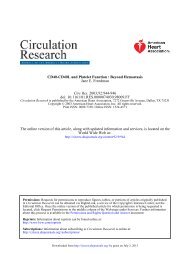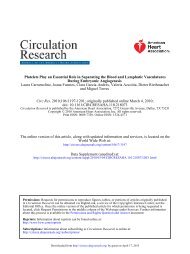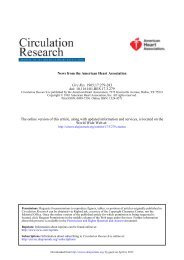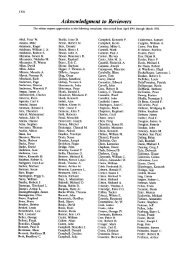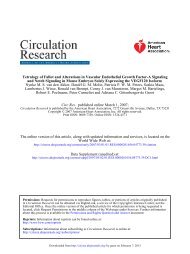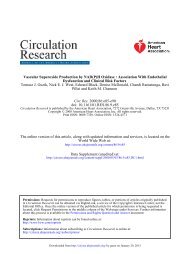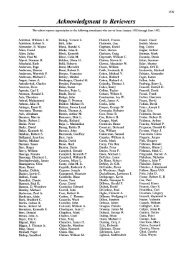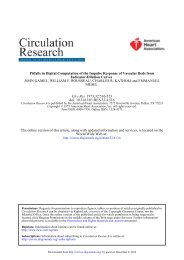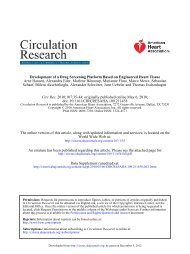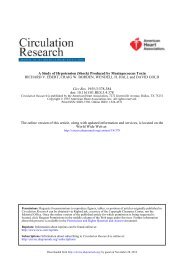Role of Sarcoplasmic Reticulum in Arterial Contraction: Comparison ...
Role of Sarcoplasmic Reticulum in Arterial Contraction: Comparison ...
Role of Sarcoplasmic Reticulum in Arterial Contraction: Comparison ...
Create successful ePaper yourself
Turn your PDF publications into a flip-book with our unique Google optimized e-Paper software.
have shown that ryanod<strong>in</strong>e is effective on vascular<br />
smooth muscle. 3>2O ~ 22 In contrast to caffe<strong>in</strong>e, which<br />
causes a rapid release <strong>of</strong> calcium from SR with a<br />
transient contraction, ryanod<strong>in</strong>e usually does not itself<br />
<strong>in</strong>duce a rise <strong>in</strong> tension. Furthermore, ryanod<strong>in</strong>e does<br />
not appear to affect the contractile apparatus or the<br />
sarcolemmal calcium transport mechanisms. 18 Therefore,<br />
this alkaloid may be especially useful for assess<strong>in</strong>g<br />
the relative role <strong>of</strong> the SR <strong>in</strong> vascular smooth muscle<br />
contraction. We compared the effects <strong>of</strong> ryanod<strong>in</strong>e on<br />
a conduit artery (rat thoracic aorta) and a small<br />
muscular artery (bov<strong>in</strong>e tail artery). This artery is<br />
comparable <strong>in</strong> size to the rat aorta (about 1.5 mm<br />
diameter) and is particularly <strong>in</strong>terest<strong>in</strong>g because small<br />
resistance vessels (200-300 (xm diameter), whose cells<br />
are virtually identical <strong>in</strong> morphology to those <strong>of</strong> the<br />
ma<strong>in</strong> tail artery (see "Results"), branch directly from<br />
the tail artery. These functional studies are correlated<br />
with morphological evidence that the rat aorta conta<strong>in</strong>s<br />
a much more extensive SR than does the bov<strong>in</strong>e tail<br />
artery. Prelim<strong>in</strong>ary reports <strong>of</strong> some <strong>of</strong> these f<strong>in</strong>d<strong>in</strong>gs<br />
have been published <strong>in</strong> abstract form. 23 - 24<br />
Materials and Methods<br />
Tissues<br />
Small r<strong>in</strong>gs <strong>of</strong> artery (approximately 1.5 mm diameter<br />
and 2-3 mm long) were obta<strong>in</strong>ed from bov<strong>in</strong>e tail<br />
artery (distal end) and rat thoracic aorta. Normal<br />
Sprague-Dawley rats (200-300 g) were killed by<br />
decapitation. The thoracic aorta was rapidly excised<br />
and placed <strong>in</strong>to Krebs solution at 37° C. Tails from<br />
normal steers were obta<strong>in</strong>ed at a local slaughterhouse.<br />
The distal end <strong>of</strong> the bov<strong>in</strong>e tail artery was excised<br />
with<strong>in</strong> 1-1 Vi hours <strong>of</strong> slaughter and placed <strong>in</strong>to Krebs<br />
solution. In all tension experiments, the arteries were<br />
cleaned <strong>of</strong> surround<strong>in</strong>g connective tissue and equilibrated<br />
<strong>in</strong> the warm Krebs solution until rest<strong>in</strong>g tension<br />
was stabilized at 500 mg (for at least 1 hour) before data<br />
collection was <strong>in</strong>itiated.<br />
Solutions<br />
The tissues were <strong>in</strong>cubated <strong>in</strong> a modified Krebs<br />
solution conta<strong>in</strong><strong>in</strong>g (mM) NaCl 138, KC1 4.7,<br />
NaH2PO4 1.2, CaCl2 1.8, MgSO4 1.2, glucose 10,<br />
HEPES 10, adjusted to pH 7.4 with Tris and gased with<br />
100% O2. In some experiments, the potassium concentration<br />
was <strong>in</strong>creased by replac<strong>in</strong>g some <strong>of</strong> the<br />
sodium chloride with equimolar potassium chloride. In<br />
0-calcium solutions, calcium was replaced with equimolar<br />
MgCl2. In low-sodium solutions (sodium 1.2<br />
mM) Af-methyl-glucam<strong>in</strong>e (138 mM) was used as the<br />
substitut<strong>in</strong>g cation and pH was adjusted to 7.4 with<br />
hydrogen chloride.<br />
Special Reagents and Drugs<br />
The follow<strong>in</strong>g drugs were used: ryanod<strong>in</strong>e (Penick<br />
Corp, Lyndhurst, New Jersey), dantrolene-Na and<br />
diltiazem (Tanabe Co, Japan), nitrendip<strong>in</strong>e (Miles<br />
Pharmaceuticals, Westhaven, Connecticut), verapamil-HCl<br />
(Knoll Pharmaceuticals, Whippany, New<br />
Jersey), /-norep<strong>in</strong>ephr<strong>in</strong>e-HCl and caffe<strong>in</strong>e (Sigma<br />
Ashida et al Ryanod<strong>in</strong>e, <strong>Sarcoplasmic</strong> <strong>Reticulum</strong>, and <strong>Arterial</strong> <strong>Contraction</strong> 855<br />
Chemical, St. Louis, Missouri), and prazos<strong>in</strong>-HCl<br />
(Pfizer Laboratories, New York). Dantrolene and<br />
nitrendip<strong>in</strong>e were kept as 10-mM stock solutions <strong>in</strong><br />
poryethylenegh/col (#400) <strong>in</strong> opaque conta<strong>in</strong>ers.<br />
These agents were added to the Krebs solution as<br />
<strong>in</strong>dicated <strong>in</strong> "Results."<br />
<strong>Contraction</strong> Measurements<br />
Two th<strong>in</strong> (0.4 mm diameter) sta<strong>in</strong>less steel hooks<br />
were <strong>in</strong>serted through the lumen <strong>of</strong> the artery r<strong>in</strong>g. One<br />
hook was fixed to the floor <strong>of</strong> a small jacketed tissue<br />
chamber (volume 0.75 ml); the other hook was<br />
connected to a Harvard Model #52-9529 or Model<br />
#363 force transducer (South Natick, Massachusetts)<br />
that was mounted immediately above the tissue chamber.<br />
Isometric tension was cont<strong>in</strong>uously monitored and<br />
recorded on a strip chart recorder. The tissue was<br />
steadily supervised at a rate <strong>of</strong> 2 ml/m<strong>in</strong> with welloxygenated<br />
<strong>in</strong>cubation fluid at 37° C. Most drugs and<br />
other reagents were added directly to the superfusion<br />
fluids and allowed to reach a steady concentration <strong>in</strong> the<br />
<strong>in</strong>cubation fluid with<strong>in</strong> the tissue chamber. Usually,<br />
however, norep<strong>in</strong>ephr<strong>in</strong>e (NE) was applied as a small<br />
(25 |il) bolus <strong>in</strong>jection <strong>in</strong>to the superfusion l<strong>in</strong>e; the NE<br />
was thus diluted 30-fold when it reached the tissue<br />
chamber. Under these circumstances, the concentration<br />
<strong>of</strong> NE <strong>in</strong> the <strong>in</strong>cubation chamber rose rapidly to a peak<br />
that lasted 15-25 seconds; the NE concentration then<br />
decl<strong>in</strong>ed with a half-time <strong>of</strong> 15 seconds. Very reproducible<br />
NE-activated contractions were normally obta<strong>in</strong>ed<br />
under these conditions (see "Results").<br />
Electron Microscopy<br />
Fresh segments <strong>of</strong> rat aorta and bov<strong>in</strong>e tail artery (three<br />
animals each) were fixed <strong>in</strong> 2.5% glutaraldehyde and<br />
postfixed for 30 m<strong>in</strong>utes with 1% OsO4 <strong>in</strong> cacodylate<br />
buffer. Subsequently, the tissue was dehydrated and<br />
embedded <strong>in</strong> Epon. Th<strong>in</strong> sections (60-90 nm) were<br />
poststa<strong>in</strong>ed with uranyl acetate and lead citrate and<br />
exam<strong>in</strong>ed <strong>in</strong> a Zeiss 10 CA electron microscope.<br />
Morphometry<br />
Grids were coded, and random micrographs were<br />
obta<strong>in</strong>ed without knowledge <strong>of</strong> the tissue <strong>of</strong> orig<strong>in</strong>. If,<br />
at the magnification necessary to visualize SR, the<br />
entire cell cross-section could not be <strong>in</strong>cluded, a<br />
random region <strong>of</strong> the cell that <strong>in</strong>cluded the cell surface<br />
and part <strong>of</strong> the nucleus was chosen. Electron micrographs<br />
<strong>of</strong> four to six arterial smooth muscle cells from<br />
each animal (three rats and three steers) were taken on<br />
a random basis and enlarged to a f<strong>in</strong>al magnification <strong>of</strong><br />
25,000 x. The micrographs were evaluated morphometricalry<br />
us<strong>in</strong>g the po<strong>in</strong>t grid planimetry method. 25 A<br />
1-cm po<strong>in</strong>t grid was used for quantification <strong>of</strong> nucleusfree<br />
cell volume. The area <strong>of</strong> SR (membrane-bound<br />
cytoplasmiccisternae, tubules, and vesicles) and rough<br />
endoplasmic reticulum (RER; ribosome-covered membranes)<br />
was quantitated with a 0.5-cm po<strong>in</strong>t grid. These<br />
data were expressed as volume percent <strong>of</strong> nucleus-free<br />
cell volume, giv<strong>in</strong>g a proportional estimate <strong>of</strong> SR and<br />
RER content <strong>in</strong> the cytoplasm.<br />
Downloaded from<br />
http://circres.ahajournals.org/ by guest on April 6, 2013




